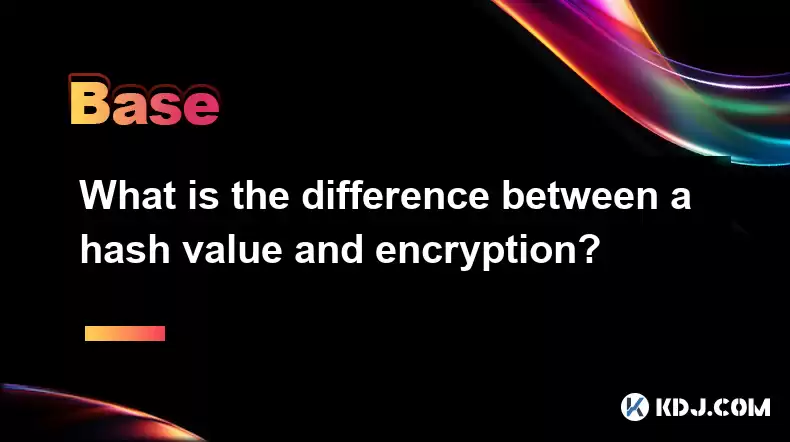-
 bitcoin
bitcoin $120167.907534 USD
1.27% -
 ethereum
ethereum $4468.611945 USD
2.53% -
 xrp
xrp $3.013607 USD
1.80% -
 tether
tether $1.000549 USD
-0.01% -
 bnb
bnb $1092.592149 USD
6.28% -
 solana
solana $231.391244 USD
4.59% -
 usd-coin
usd-coin $0.999699 USD
-0.04% -
 dogecoin
dogecoin $0.259020 USD
4.30% -
 tron
tron $0.342747 USD
0.34% -
 cardano
cardano $0.860977 USD
1.07% -
 hyperliquid
hyperliquid $50.155412 USD
5.34% -
 chainlink
chainlink $22.637678 USD
0.46% -
 ethena-usde
ethena-usde $1.000528 USD
-0.07% -
 avalanche
avalanche $30.613779 USD
-0.07% -
 stellar
stellar $0.403905 USD
0.94%
What is the difference between a hash value and encryption?
Hashing, a one-way function ensuring data integrity in blockchains, differs from two-way encryption, which protects data confidentiality by transforming readable data into an unreadable format and back again using keys.
Feb 27, 2025 at 08:01 pm

What is the difference between a hash value and encryption?
Key Points:- Hashing: A one-way function producing a fixed-size output (hash) from any input, ensuring data integrity but not confidentiality. It's crucial for blockchain technology's security.
- Encryption: A two-way process involving an algorithm and a key to transform readable data (plaintext) into an unreadable format (ciphertext) and back again, protecting data confidentiality. It's vital for securing private keys and transactions in cryptocurrencies.
- Key Differences: Hashing is irreversible, while encryption is reversible. Hashing focuses on data integrity, while encryption focuses on data confidentiality. They serve different but complementary roles in cryptocurrency security.
- The Irreversible Nature of Hashing: A hash function takes an input of any size and produces a fixed-size output, known as the hash value or digest. This output is deterministic, meaning the same input will always produce the same hash. Critically, however, this process is computationally infeasible to reverse. You cannot determine the original input from its hash value. This one-way nature is fundamental to the security of blockchain technology. Imagine trying to crack a password; instead of directly accessing the password, systems often store only its hash value. If someone tries to guess the password, the system compares the hash of the guessed password to the stored hash. A match confirms the correct password, but the actual password itself remains hidden. This is analogous to how blockchains use hashing to verify data integrity without revealing the underlying data. The irreversible nature of hashing prevents malicious actors from altering data without detection. Any change to the input data, however small, will result in a completely different hash value. This makes it instantly apparent if a block in a blockchain has been tampered with, thus preserving the integrity of the entire system. The computational complexity of reversing a hash function, even with significant computing power, ensures that this verification process remains secure and reliable. This property is essential for maintaining trust and transparency in the decentralized nature of cryptocurrencies. The security of numerous cryptographic systems relies heavily on the difficulty of inverting hash functions.
- Hashing and Blockchain Integrity: In the context of cryptocurrencies, hashing is integral to the blockchain's structure and security. Each block in a blockchain contains a hash of the previous block, creating a chain of linked blocks. This chain acts as an immutable ledger, as any alteration to a block would change its hash value, creating a mismatch with the subsequent block's hash. This mismatch immediately signals a potential attack or data corruption. This chaining mechanism ensures data integrity across the entire blockchain, a crucial aspect of trust and security in cryptocurrency transactions. The security of the blockchain relies on the cryptographic strength of the hash function used. The function needs to be resistant to collisions (where two different inputs produce the same hash) and pre-image attacks (finding an input that produces a specific hash). Algorithms like SHA-256 (Secure Hash Algorithm 256-bit) are widely used because they meet these criteria, making it incredibly difficult for attackers to tamper with the blockchain without detection. The sheer volume of computational power required to manipulate even a single block in a major blockchain makes such an attempt impractical and extremely costly. Furthermore, the decentralized nature of blockchain networks makes it exponentially harder to alter data because consensus among multiple nodes is required to validate any changes.
- Hashing in Digital Signatures: Beyond blockchain integrity, hashing plays a vital role in digital signatures, which are crucial for verifying the authenticity of transactions in cryptocurrencies. A digital signature doesn't directly encrypt the message; instead, it uses a cryptographic hash function to generate a digest of the message. This digest is then signed using the sender's private key. The recipient can verify the signature using the sender's public key, ensuring both the authenticity and integrity of the message. If the message has been altered in any way, the hash value will change, invalidating the signature. This process prevents forgery and ensures that only the intended sender could have created the signature. The security of this process rests on the cryptographic properties of the hash function and the strength of the public-key cryptography used for the signature scheme. This combination provides a robust mechanism for verifying the legitimacy of transactions in the cryptocurrency ecosystem. The use of hashing in digital signatures is crucial for preventing double-spending and ensuring the trustworthiness of transactions on a decentralized network.
- The Reversible Nature of Encryption: Unlike hashing, encryption is a two-way process. It involves transforming readable data (plaintext) into an unreadable format (ciphertext) using an encryption algorithm and a secret key. The ciphertext can be decrypted back into the original plaintext using the same algorithm and the corresponding decryption key. This reversibility is crucial for protecting the confidentiality of sensitive data, particularly private keys and transaction details in the cryptocurrency world. Strong encryption algorithms are designed to make it computationally infeasible for unauthorized individuals to decrypt the ciphertext without possessing the correct decryption key. This ensures that only the intended recipient, possessing the decryption key, can access the original data. The strength of an encryption algorithm depends on its resistance to various attacks, including brute-force attacks (trying all possible keys) and cryptanalysis (analyzing the algorithm's structure to find weaknesses). Modern encryption algorithms are designed to withstand these attacks, ensuring that the encrypted data remains confidential.
- Encryption and Private Key Security: In cryptocurrencies, private keys are crucial for authorizing transactions. These keys must be protected from unauthorized access to prevent theft or fraudulent activities. Encryption is a fundamental tool for securing private keys. Various methods, including hardware wallets and software encryption, are used to protect these keys from unauthorized access. Hardware wallets, for instance, store private keys in a physically secure environment, making them extremely difficult to compromise. Software encryption techniques use cryptographic algorithms to encrypt private keys on a user's device, requiring a password or passphrase for decryption. The strength of these security measures depends heavily on the robustness of the encryption algorithm used and the security practices implemented by the user. Strong passwords, regular software updates, and careful handling of private keys are essential for maintaining the security of cryptocurrencies.
- Encryption in Secure Communication: Encryption is also vital for secure communication in the cryptocurrency space. For example, securing communication channels between a user's device and a cryptocurrency exchange is essential to prevent eavesdropping and man-in-the-middle attacks. These attacks involve intercepting communication between two parties to steal sensitive data, such as login credentials or transaction details. Encryption protects against such attacks by ensuring that only the intended recipient can understand the transmitted data. The use of Transport Layer Security (TLS) and Secure Sockets Layer (SSL) protocols is widespread in the cryptocurrency industry to secure communication channels. These protocols use encryption algorithms to encrypt data transmitted between a user's device and a server, protecting it from unauthorized access. The strength of these protocols relies on the underlying encryption algorithms and the implementation of secure key exchange mechanisms. Proper implementation and regular updates of these protocols are crucial for maintaining the security of communication channels in the cryptocurrency ecosystem.
- Encryption and Transaction Confidentiality: While blockchain transactions are publicly visible, the identities of the participants are often obscured through techniques that leverage encryption and cryptography. Addresses, rather than personal information, are used to identify participants. This allows for a degree of anonymity, while the underlying transaction data is still verifiable on the blockchain. Furthermore, advanced encryption techniques can further enhance privacy by obscuring transaction details, making it more difficult to link transactions to specific individuals. This is a critical aspect of privacy-focused cryptocurrencies. The effectiveness of these techniques relies on the robustness of the encryption algorithms and the implementation of privacy-enhancing technologies.
A: No. Hashing is a one-way function; it's impossible to reverse the process to obtain the original input from the hash value. Encryption, on the other hand, is a two-way process, allowing for the recovery of the original data. They serve completely different purposes.
Q: What are some common hash functions used in cryptocurrencies?A: SHA-256 (Secure Hash Algorithm 256-bit) is very prevalent, as is RIPEMD-160. The choice of hash function is critical for the security of the cryptocurrency system.
Q: What are some common encryption algorithms used in cryptocurrencies?A: AES (Advanced Encryption Standard) is widely used for its robustness and security. Elliptic curve cryptography (ECC) is also commonly employed, particularly in digital signature schemes.
Q: Is it possible to break encryption or a hash function?A: While theoretically possible to break any cryptographic system, the computational cost to break modern, well-designed algorithms like AES or SHA-256 is astronomically high, making it practically infeasible with current technology. However, advancements in computing power and cryptanalysis could potentially weaken these systems in the future. Therefore, it's crucial to regularly update and improve cryptographic algorithms and security protocols.
Disclaimer:info@kdj.com
The information provided is not trading advice. kdj.com does not assume any responsibility for any investments made based on the information provided in this article. Cryptocurrencies are highly volatile and it is highly recommended that you invest with caution after thorough research!
If you believe that the content used on this website infringes your copyright, please contact us immediately (info@kdj.com) and we will delete it promptly.
- BlockDAG, DOGE, HYPE Sponsorship: Crypto Trends Shaping 2025
- 2025-10-01 00:25:13
- Deutsche Börse and Circle: A StableCoin Adoption Powerhouse in Europe
- 2025-10-01 00:25:13
- BlockDAG's Presale Buzz: Is It the Crypto to Watch in October 2025?
- 2025-10-01 00:30:13
- Bitcoin, Crypto, and IQ: When Genius Meets Digital Gold?
- 2025-10-01 00:30:13
- Stablecoins, American Innovation, and Wallet Tokens: The Next Frontier
- 2025-10-01 00:35:12
- NBU, Coins, and Crypto in Ukraine: A New Yorker's Take
- 2025-10-01 00:45:14
Related knowledge

How does cryptocurrency achieve decentralization?
Sep 30,2025 at 04:37am
Understanding the Foundation of Decentralization in Cryptocurrency1. Cryptocurrency achieves decentralization primarily through the use of blockchain ...

What are some common methods of cryptocurrency market manipulation?
Sep 27,2025 at 02:55am
Wash Trading and Its Impact on Market Perception1. Wash trading involves an individual or entity simultaneously buying and selling the same cryptocurr...

How do I read a cryptocurrency whitepaper?
Sep 27,2025 at 05:54am
Understanding the Structure of a Cryptocurrency Whitepaper1. Begin by identifying the executive summary, which outlines the project’s core vision and ...

Can I recover lost cryptocurrency?
Sep 25,2025 at 08:18am
Understanding the Nature of Cryptocurrency Loss1. Cryptocurrency operates on decentralized networks, meaning there is no central authority to reverse ...

How do I choose a cryptocurrency investment strategy?
Sep 27,2025 at 03:55pm
Understanding Risk Tolerance in Crypto Investing1. Assessing personal risk tolerance is a foundational step when entering the cryptocurrency market. V...

How can I earn passive income from cryptocurrency?
Sep 23,2025 at 10:18am
Staking Cryptocurrencies for Regular Returns1. Many blockchain networks operate on a proof-of-stake (PoS) consensus mechanism, allowing users to earn ...

How does cryptocurrency achieve decentralization?
Sep 30,2025 at 04:37am
Understanding the Foundation of Decentralization in Cryptocurrency1. Cryptocurrency achieves decentralization primarily through the use of blockchain ...

What are some common methods of cryptocurrency market manipulation?
Sep 27,2025 at 02:55am
Wash Trading and Its Impact on Market Perception1. Wash trading involves an individual or entity simultaneously buying and selling the same cryptocurr...

How do I read a cryptocurrency whitepaper?
Sep 27,2025 at 05:54am
Understanding the Structure of a Cryptocurrency Whitepaper1. Begin by identifying the executive summary, which outlines the project’s core vision and ...

Can I recover lost cryptocurrency?
Sep 25,2025 at 08:18am
Understanding the Nature of Cryptocurrency Loss1. Cryptocurrency operates on decentralized networks, meaning there is no central authority to reverse ...

How do I choose a cryptocurrency investment strategy?
Sep 27,2025 at 03:55pm
Understanding Risk Tolerance in Crypto Investing1. Assessing personal risk tolerance is a foundational step when entering the cryptocurrency market. V...

How can I earn passive income from cryptocurrency?
Sep 23,2025 at 10:18am
Staking Cryptocurrencies for Regular Returns1. Many blockchain networks operate on a proof-of-stake (PoS) consensus mechanism, allowing users to earn ...
See all articles










































































